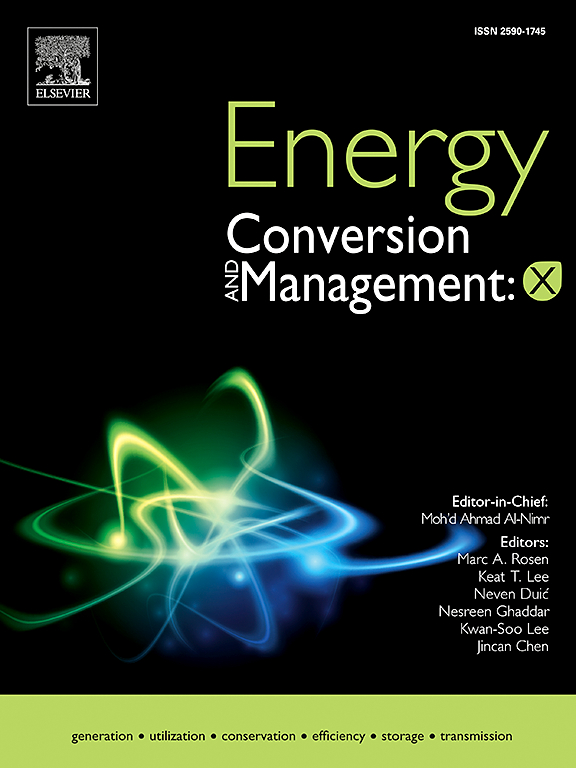地质储碳条件下石油烃类生物制氢
IF 9.9
1区 工程技术
Q1 ENERGY & FUELS
引用次数: 0
摘要
我们发现,超临界CO2和枯竭油藏中富含蛋白质物质的可用性可以导致本地微生物群落从石油碳氢化合物中生物生产H2。我们的实验结果支持这样的假设,即由于超临界CO2溶解到地层水中,pH值降低到酸性水平,并且富含蛋白质的物质的可用性有利于产生h2的微生物群落的活性,而不是利用h2的微生物群落的活性。为了确定在注入富含蛋白质物质的CO2和采出水(PW)的枯竭油藏中,在何时何地可以生产氢气,以及可以生产多少氢气,我们模拟了Morrow B砂岩油藏的生物产氢。利用CO2Bio软件模拟地质碳库(GCS)中CO2-CH4-H2-H2S气体多相生物地球化学反应输运过程。通过批反应实验结果验证了CO2Bio的微生物学性能。现场模拟结果表明,单井径向流注入CO2和PW 100天后,H2产量可达154 ~ 1673 kg,砂岩储层比碳酸盐岩储层更适合从溶解烃中生产H2。基于已获得的实验和模拟结果,我们提出了一种新的制氢方法,将GCS和PW处理结合在枯竭油藏中,以减轻二氧化碳污染大气、PW污染淡水资源和能源枯竭带来的全球变暖相关环境和能源问题。本文章由计算机程序翻译,如有差异,请以英文原文为准。

Biogenic hydrogen production from oil hydrocarbons at geological carbon storage conditions
We found that supercritical CO2 and the availability of protein-rich matter in depleted oil reservoirs can result in the biogenic production of H2 from oil hydrocarbons by indigenous microbial communities. Our experimental results support the hypothesis that a decrease in pH to acidic levels due to the dissolution of supercritical CO2 into the formation water and availability of protein-rich matter favors the activity of H2-producing microbial communities over the activity of H2-using microbial communities. To determine where, when, and how much H2 could be produced in a depleted oil reservoir injected with CO2 and produced water (PW) supplied with protein-rich matter, we simulated the biogenic production of H2 for the Morrow B sandstone reservoir. Simulations were conducted using CO2Bio, a program developed to simulate the multiphase bio-geochemical reactive transport of CO2-CH4-H2-H2S gases in geological carbon storage (GCS) sites. The microbiological capabilities of CO2Bio are validated against batch reaction experimental results. Our field-scale simulation results indicate that 154 – 1673 kg of H2 could be produced after 100 days of CO2 and PW co-injection into a single well of radial flow, and that sandstone reservoirs are more suitable than carbonate reservoirs to produce H2 from dissolved hydrocarbons. Based on the obtained experimental and simulation results, we propose a new H2 production method that couples GCS and PW disposal in depleted oil reservoirs to attenuate environmental and energy issues related to global warming derived from atmospheric pollution with CO2, risk of freshwater resources contamination with PW, and depletion of energy resources.
求助全文
通过发布文献求助,成功后即可免费获取论文全文。
去求助
来源期刊

Energy Conversion and Management
工程技术-力学
CiteScore
19.00
自引率
11.50%
发文量
1304
审稿时长
17 days
期刊介绍:
The journal Energy Conversion and Management provides a forum for publishing original contributions and comprehensive technical review articles of interdisciplinary and original research on all important energy topics.
The topics considered include energy generation, utilization, conversion, storage, transmission, conservation, management and sustainability. These topics typically involve various types of energy such as mechanical, thermal, nuclear, chemical, electromagnetic, magnetic and electric. These energy types cover all known energy resources, including renewable resources (e.g., solar, bio, hydro, wind, geothermal and ocean energy), fossil fuels and nuclear resources.
 求助内容:
求助内容: 应助结果提醒方式:
应助结果提醒方式:


